一個古老盆地改變了世界能源格局,來看看它的風采
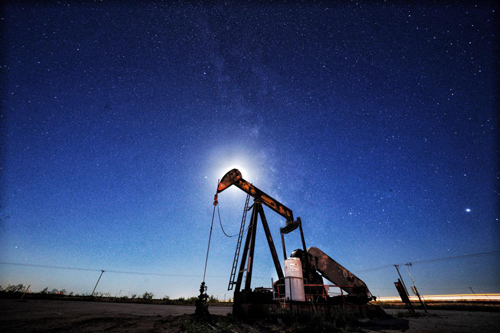
|
格里爾·布倫森一家在西得州有塊45平方英里(116.55平方公里)的農場,當中鑲嵌著一塊郁郁蔥蔥的洼地,他們稱之為“小坑”。 幾千年前,普韋布洛人在這兒建立了石頭村落。幾百年前,科曼奇族印第安人如奔雷般在這片平原上縱馬馳騁。如今,“小坑”內外的自然資源引來的則是相當現代化的人流。 洼地邊上,在牧豆樹和灌木蒿之間,隆隆作響的石油鉆機就像正在發射的火箭,一個油井壓裂小組正通過一臺巨大、響聲持續而單調的液壓泵把難以計數的水和幾百卡車沙土灌入地下。對布倫森一家來說,這樣的場景和那些聲音意味著收入——從地下2英里(3.22公里)的石頭縫里擠出的石油正通過精心鉆出的孔洞抽取出來,日產量可達數千桶,價值幾百萬美元。 |
Smack in the middle of Grier Brunson’s family’s ranch, a patch of West Texas dirt that sprawls across 45 square miles, sits a lush, green dip in the land that the family calls “the draw.” Thousands of years ago, ?Pueblos built rocky settlements here. Hundreds of years ago, Comanches thundered on horseback across this plain. Today, the natural bounty in and around the draw is producing a rather more modern stampede. On the rim of the draw, amid the mesquite trees and the sagebrush, oil rigs loom like rockets at launch, and a team fracking a well shoots untold thousands of gallons of water and hundreds of truckloads of sand down into the earth, using huge hydraulic pumps that emit a dull, constant roar. For the Brunson family, these are the sights and sounds of money: Two miles underground, oil—thousands of barrels of it every day, worth millions of dollars—is being cracked loose from the rock and pulled up through carefully engineered holes. |
二疊紀盆地剪影
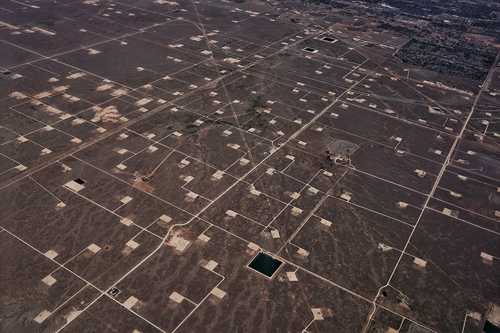
米德蘭德附近鉆井作業區夜間航拍。攝影師本杰明·羅伊在兩個時區用了五天時間來拍攝人物、過程、地點和石油。
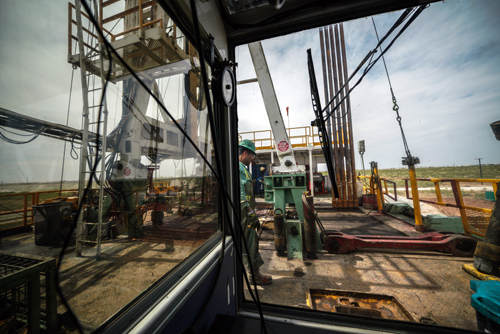
工人在得州米德蘭德操作鉆機。
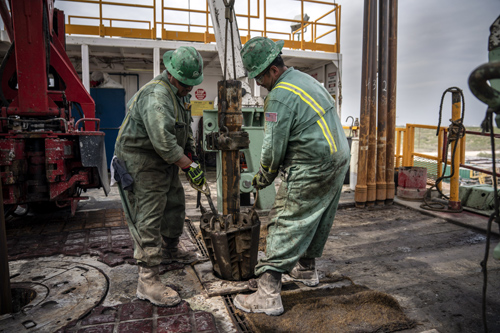
工人在得州米德蘭德操作鉆機。

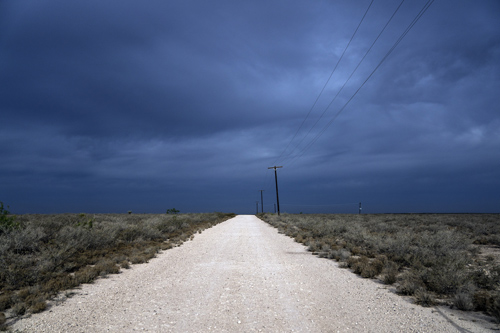
拉夫靈縣的一條路。
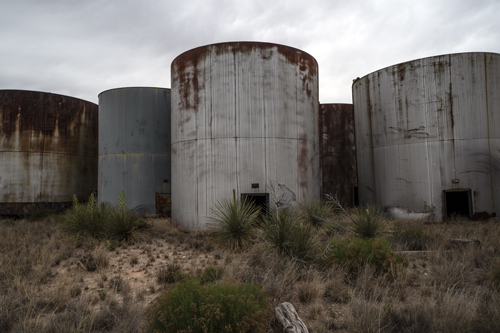
敖德薩和佩科斯之間生銹的儲油罐。

得州佩科斯Pody's BBQ餐館的石油工人。

拖車公園等待入場的名單排到了兩年以后,費用約為每月2000美元。
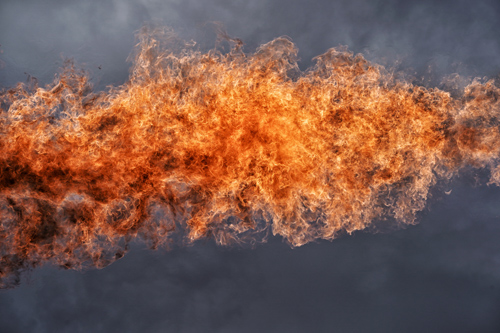
得州佩科斯附近一口油井的天然氣火炬。
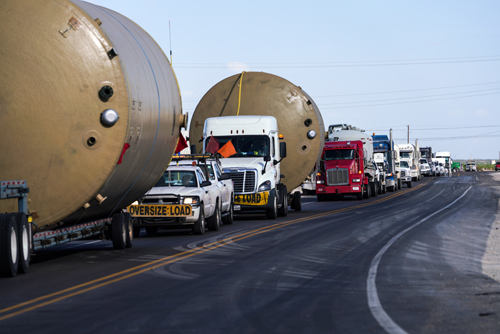
蒙通和奧拉之間的路況。卡車裝著沙子,還有數千輛卡車裝著水、石油、管道、泵、油罐以及油田需要的其他所有東西。
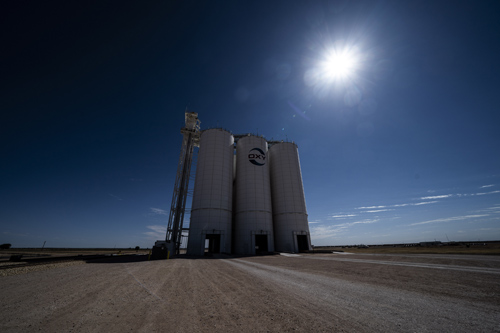
西方石油公司的沙土筒倉。該公司提供壓裂用沙土。

西方石油公司油田用于壓裂的沙土。
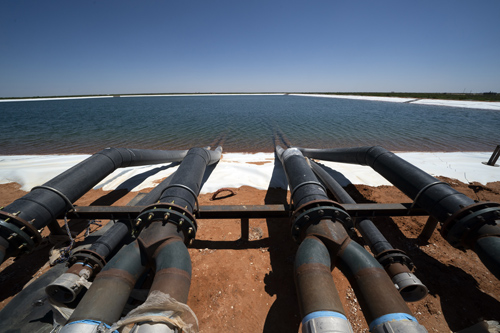
贊恩·奇勒所有土地中的一個淡水坑。
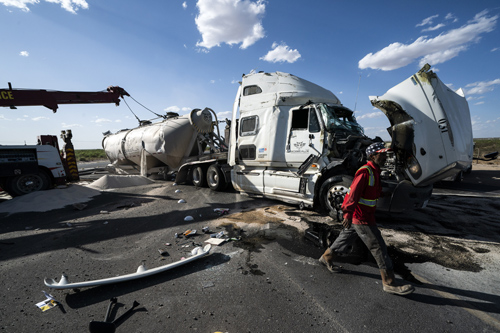
由于出現大量致死事故,285號公路被稱為“死亡之路”。
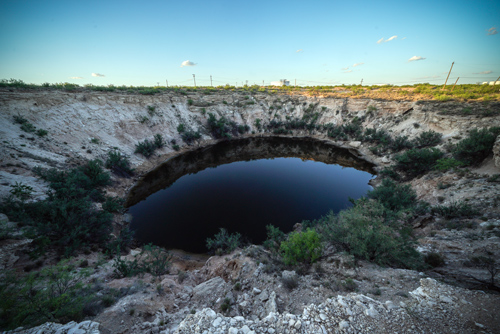
得州克米特的塌陷坑。二疊紀盆地的某些地區不光有地震,還有地陷。
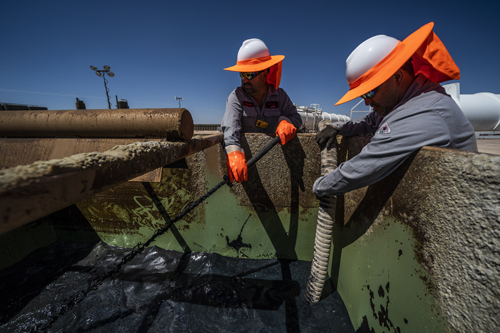
Doer Rite貨車運輸公司的工人在石油公司走后進行清理。

快餐車主查克·弗拉切為石油工人提供服務。
|
按照和石油公司簽的礦物租賃協議,后者將把石油開采收入的四分之一分給布倫森和他的一大家子人。他們的農場上有大約50口油井,規模和井齡各不相同。按每桶約70美元的價格計算,其中最賺錢的油井每年能給布倫森一家帶來的稅前特許權使用費高達380萬美元。這還只是石油。與石油一同開采出來的天然氣和其他烴類還會產生額外的特許權使用費。另外,鉆井公司安裝輸油管道等基礎設施要經布倫森一家同意,并向他們繳納手續費。 對布倫森來說,這筆意外之財的數量有點兒詭異,而且讓他覺得有些難堪。布倫森平常開著GMC皮卡,以差不多100年前在這里放牛的爺爺為偶像,當他開車穿過農場,看到租用土地的石油公司把這里搞的一團糟時,還會像牛仔一樣說臟話。布倫森說,這筆錢“超過了我們的需要。我們不知道拿它怎么辦,而它卻不停地來。”73歲的布倫森戴著眼鏡,很消瘦,他的白色山羊胡讓人想起肯德基老爺爺,他的口才則會讓人聯想到幽默大師威爾·羅杰斯。 布倫森表示:“我們可不打算變得超乎想象的富有。但看來事情一定會變成這樣。” 確實,當石油行業出現歷史上數得著的大發展而命運又把你的農場放在風口上時,想不發大財都難。布倫森的農場位于二疊紀盆地核心地帶,這個富含石油的盆地橫跨得州西部和新墨西哥州東南部,面積比北達科他州還大。二疊紀盆地的石油產量正處于“井噴”狀態,就算按得州最高的標準衡量也是如此。在美國這片炎熱的土地上,石油行業的繁榮改變了生活的方方面面,有好的變化,也有壞的,而且在全球各地都能聽到它的回響。 |
Under the terms of the mineral leases they’ve signed with oil companies, Brunson and his extended family receive one-quarter of the revenue from every barrel the drilling companies pull up. The Brunsons have about 50 wells on the ranch, of various sizes and ages. With oil trading around $70 per barrel, among the most prolific of those wells could generate as much as $3.8 million per year in royalties before taxes for the Brunsons. And that’s just for the oil. The Brunsons earn additional royalties from the sale of the natural gas and other hydrocarbons that come up with the oil. And they earn fees from the drilling companies for permission to install infrastructure such as pipelines. The size of this unexpected windfall is a bit bizarre and more than a little embarrassing to Brunson, who drives a GMC pickup, idolizes a grandfather who rustled cattle here nearly 100 years back, and curses like a cowboy—“goddamn it!”—when he drives across his ranch and sees what he regards as messy operations by the oil companies leasing his land. The money “is more than we need. We don’t know what to do with it. But it keeps coming,” says Brunson, a lanky, bespectacled 73-year-old, who evokes Colonel Sanders with his silver goatee and Will Rogers with his silver tongue. “We have no inclination to be rich beyond our wildest dreams,” he adds. “Apparently, it’s going to happen anyway.” Indeed, it’s hard not to rack up wealth when fate puts your ranch at the epicenter of one of the biggest oil booms in history. Brunson’s land sits in the bull’s-eye of the Permian Basin, a ?petroleum-rich swath of western Texas and southeastern New Mexico—bigger than North Dakota—that is experiencing a gusher of production growth epic even by the outsize standards of the Lone Star State. The boom is remaking every aspect of life in this parched part of the country, for good and for ill. And it is reverberating across the globe. |

|
二疊紀盆地的橫空出世正在改變能源地緣政治格局。今年5月,該盆地石油日產量飆升至320萬桶。受此推動,今年2月美國整體石油日產量突破1020萬桶。美國能源信息署的數據顯示,這是1920年聯邦政府開始記錄相關數字以來的最高水平,甚至超過了1970年11月1000萬桶的高點。據市場數據公司Baker Hughes介紹,今年4月在二疊紀盆地作業的鉆機平均數量為449臺,占當月美國作業鉆機的44%,全球的22%。該公司的數據表明,過去兩年在二疊紀盆地作業的鉆機數量增加了兩倍以上。一年來油價大幅上升讓鉆機作業變得更為急迫。 有人把二疊紀盆地的石油資源和沙特的加瓦爾油田相提并論——外界廣泛認為加瓦爾油田是所有超大型油藏,也就是業界所說的“大象級”油田所在地。埃克森美孚旗下XTO能源公司(XTO Energy)總裁薩拉·奧特韋恩說,二疊紀盆地“資源量巨大,而且將對全世界產生影響”。埃克森美孚在今年的《財富》美國500強名單中位列第二。它已經是二疊紀盆地的最大石油生產商之一,而且計劃到2025年將在該盆地的產量提高兩倍。美國西方石油公司(Occidental Petroleum)在今年的《財富》美國500強名單排在第220位,也是在二疊紀盆地加倍下注的主要石油公司之一。該公司首席執行官薇姬·霍勒布也表示,這個地區是“世界上最好的盆地之一”。 讓石油公司高層垂涎不已的是此前100年的生產對二疊紀盆地來說或許僅僅是個開始。 1923年,米德蘭德東南部一口名為Santa Rita一號的油井打出了石油,從那時起,人們就知道二疊紀盆地是個大油田,那口井現在也成了傳奇。地面上散布的采油機是一代代石油人在這里鉆探的絕佳證據。地質學家估算,該盆地現有的逾40萬口油井已經開采了大約300億桶石油。而行業分析公司Wood Mackenzie認為,仍留存在地下的,或者用行話來說,“可采儲量”是這個數字的2-3倍。 讓二疊紀盆地如此有吸引力的原因在于它是一個巨大的淺盆地。在數百萬年時間里,動物的死亡和腐爛以及沉積物的堆壘造就了無數含油巖層,特別是頁巖。石油人把巖層稱為油層單元,它就像一個石頭般堅硬的煎餅,里面充滿了烴類“糖漿”,等待著人們去開采和銷售。就這些“煎餅”的數量及其厚度來說,二疊紀盆地可謂無可匹敵。 “市場目前正在熱炒。每個人都想在二疊紀盆地占據一席之地。” ——阿米爾·格爾斯:殼牌二疊紀地區總經理 石油行業無法用頁巖油賺錢的情況曾延續了幾十年——那時石油公司只能在其他較容易開采的巖層構造中生產石油。要想弄清楚其中的原因,大家首先要明白,地下油藏并不是在巨大的池子里;相反,它存在于巖石的細小孔洞中,就像海綿中的水。最容易開采的巖層孔隙度要高(也就是說有大孔),滲透性還要好(孔洞相互連接的很好)。頁巖的這兩項指標往往都很低。用行話來說就是,它是致密巖層,石油實際上被封在了里面。 隨后,壓裂技術革命改變了游戲規則。大概10年前,新技術讓致密頁巖采油對石油公司來說有了性價比。其要點在于結合橫向鉆井,從而使每口油井都覆蓋一大片區域,然后用工業規模的液體壓裂使致密巖石破碎。石油公司最初把這些技術用于規模較小的頁巖層,原因是采掘難度較小。比如北達科他州、蒙大拿州和加拿大的巴肯構造以及南得州的伊格福特。二疊紀盆地的構造更為復雜,但石油儲量也大得多。現在,石油工人已經掌握了這里的地質情況,這個盆地的石油產量開始“井噴”。 |
The emergence of the Permian is changing the geopolitics of energy. Oil production in the Permian soared to 3.2 million barrels per day in May. And it helped push total U.S. production above 10.2 million barrels per day in February. That was the highest that U.S. production has been since the federal government began keeping records in 1920—higher even than the prior peak of 10 million barrels per day in November 1970, according to the U.S. Energy Information Administration (EIA). In April, an average of 449 rigs were drilling holes in the Permian, according to market-data firm Baker Hughes. That was 44% of all the rigs drilling that month in the U.S. And it was 22% of all the rigs drilling in the world. Over the past two years, Baker Hughes figures show, the number of rigs drilling in the Permian has more than tripled. A surge in the price of oil over the past year has only added to the urgency of the drillers piling in. Some compare the Permian’s buried treasure to that of Saudi Arabia’s Ghawar field, widely regarded as the mother of all giant petroleum troves—what the industry calls “elephants.” The Permian is “a huge resource, and it will play out globally,” says Sara Ortwein, president of the XTO Energy unit of Exxon Mobil, No. 2 on this year’s Fortune 500, which already is one of the Permian’s biggest producers and plans to triple its output here by 2025. Adds Vicki Hollub, CEO of Occidental Petroleum, No. 220 on the 500 this year, and another major Permian player that’s doubling down in the region: The region is among “the best basins of the world.” What has oil executives salivating is that the Permian, as it finishes its first century of production, may just be getting started.?? Ever since 1923, when a now legendary oil well southeast of Midland called the Santa Rita No. 1 struck black gold, the Permian Basin has been known as a big one. The pump jacks dotting the landscape are iconic evidence that generations of oilmen have drilled this turf. Geologists estimate that the existing wells—more than 400,000 so far—have pulled up about 30 billion barrels of oil. Yet industry analysis firm Wood Mackenzie estimates two or three times that amount of oil remains underground, and “recoverable,” in industry terms. What makes the Permian so alluring is that it’s a massive geologic platter. Over millions of years, the death and decay of critters and the buildup of sediment has produced countless layers of oily rock—in particular, shale. Oilmen call each layer a “pay”—a rock-hard pancake full of hydrocarbon syrup just waiting to be tapped and sold. In the number of these pancakes and in their thickness, the Permian may well be unparalleled. “There is hype in the market now. Everybody’s trying to build a position in the Permian.” ——Amir Gerges: Royal Dutch Shell’s General Manager for the Permian Region For decades, the oil industry was unable to profitably pull much oil from shale—only from other, easier-to-tap, rock formations. Understanding why requires realizing that buried oil doesn’t exist in vast pools; rather, it sits, as if in a sponge, inside tiny holes in rocks. The rocks that are easiest to tap have both high porosity (meaning: big holes) and high permeability (holes that connect well to each other). Shale tends to have both low porosity and low permeability. It is, in the lingo, tight. Which used to mean the oil was essentially trapped. Then the fracking revolution changed the game. About a decade ago, new technology made it cost-effective for oil companies to drill in tight shale. The trick was to combine horizontal drilling, enabling each well to fan out across a wide area, with industrial-scale hydraulic fracturing, or fracking, to crack up the innards of tight rock. Initially, the industry deployed these techniques in lesser shale plays such as the Bakken formation—in North Dakota, Montana, and Canada—and in the Eagle Ford, in South Texas, because they were simpler to drill. The Permian is a more complex area, but it’s also vastly richer with oil. Now that the drillers have mastered its geology, the basin’s production has begun to explode. |
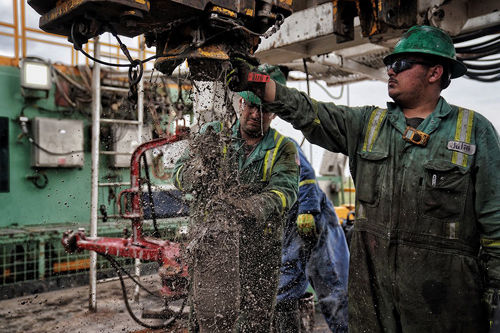
|
Wood Mackenzie預計,今后10年,二疊紀盆地將占美國新增石油產量的三分之二,全球新增石油產量的四分之一。該公司首席分析師西蒙·弗洛爾斯認為二疊紀盆地對全球的影響和北海類似,后者在大約40年前開啟了大規模深水鉆井時代。弗洛爾斯說:“二疊紀盆地的規模與之相當。” 由于存在大量油層單元,再加上已經遍布石油生產基礎設施,二疊紀盆地提升全球石油產量的成本甚至有可能低于一些傳統上一直主導石油行業的地區,比如俄羅斯和中東。弗洛爾斯指出,二疊紀盆地有相當多的地點“都處于最佳油藏甜點上”。石油公司表示,在這些地點開采的石油可在國際油價低于每桶30美元的情況下實現正回報——這要遠低于其他一些地區。弗洛爾斯稱,這給俄羅斯和歐佩克出了個難題:“午餐被二疊紀盆地搶了以后我該怎么辦?” 簡而言之,二疊紀盆地為“回到未來”的能源體系打開了一扇窗戶,這個未來從基本面上講將非常像100年前石油時代的發端。這些年來,大型石油公司在沙特、俄羅斯和西非等一系列偏遠地區開疆擴土。現在,這些公司又迫不及待地要進入西得州沙漠,而這里實際上正是它們的誕生地。 在二疊紀盆地,石油行業蓬勃發展而帶來的影響隨處可見,而且其中許多并非有利影響。雖然富人賺了錢,但窮人卻難以承擔不斷攀升的物價,從食雜到住房都是如此。這場繁榮還給基礎設施帶來了壓力,有時是很危險的壓力。當地道路過窄,交通事故死亡人數因此上升。輸油管道不足,買家不得不用卡車運走很大一部分石油,從而加劇了交通堵塞并造成了更多污染。同時,土地本身也因地震和塌陷洞而“戰栗不已”。 二疊紀盆地的樞紐是米德蘭德,一座人口約15萬的城市。它建立于19世紀80年代,最初其實是一座車站,或者說是太平洋鐵路沃斯堡-埃爾帕索段的中點。1923年Santa Rita一號井讓人們發財致富后,米德蘭德的歷史就一直隨著油價上下波動。市中心的建筑反映了石油行業繁榮期的幾波建設活動。最經典的建筑當屬市中心的石油大廈(Petroleum Building),這座華麗的12層大樓竣工于1929年,比經濟和油價崩盤早了幾個月。 吉姆·亨利可能是米德蘭德石油人的典范。1969年,三十四、五歲的亨利創立了亨利石油公司(Henry Petroleum)。2008年,他以6億美元的價格將公司轉讓。我在他的米德蘭德辦公室跟83歲的亨利見面時,他對我說:“6億美元”,目的是保證我聽清楚了這個數字。亨利的辦公桌上放著一本紫紅色封面的圣經參考書《上帝對你一切所需的應許》(God’s Promises for Your Every Need);他和布什一家的照片掛在墻上——這個總統家庭曾經住在米德蘭德;他還有一架里爾私人飛機停在機場。亨利戴著金絲眼鏡,有濃密的白色頭發,他的大腦則是一本百科全書,里面的知識都和這片讓他發家致富的土地有關。 亨利的石油公司最初開采的油層單元名叫Spraberry,在米德蘭德地下約9000英尺(約2743米)。采礦權租賃成本大概是每英畝(4,047平方米)300美元,鉆一口垂直井要花費15萬美元左右。2008年亨利把自己的公司套了現,將其轉讓給了當地競爭對手Concho Resources。如今,Spraberry在米德蘭德周邊的采礦權租賃費高達每英畝4萬美元,像亨利那樣鉆出水平井并壓裂的成本約為每口800萬美元。 二疊紀盆地的現代化石油生產是一條砂礫多但成熟的戶外流水線。和非洲或亞洲海域的深水盆地不同,在這里人們的目標并不是真的要發現油藏,因為在西得州的這個區域,油田早就已經發現了。人們在二疊紀盆地的目標更像是普通勞動者——把油藏最豐富的地段集中在手里,然后執行鉆井和壓裂計劃,從而以最低成本開采出石油。 就像硅谷軟件工程師捋順代碼來改善app性能那樣,二疊紀盆地的石油工程師用計算機記錄的當地地質情況來調整生產過程的方方面面,進而從石頭縫里榨出更多石油。他們決定著在每一平方英里土地,也就是一個開采區里打多少眼井,以及在什么的深度、相隔多遠為這些油井鉆出水平井——后者的長度一般為2英里(3.23公里)。他們還決定著從美國各地的礦山究竟購買多少專門加工的沙土以及這些沙土的粒度。這些沙土將和差不多數百萬加侖水混合,而且經常要加入某些化學品,從而制成要注入油井的壓裂液。 現代化鉆機一般都有幾層樓高,鉆頭由一名操作員控制,后者坐在被稱為“狗屋”的小亭子里,看著一排電腦屏幕并用搖桿來引導鉆頭。鉆一口井往往需要大約三周時間,然后鉆機就會靠四只巨大的“鐵腳”站起來,走到下一個要鉆井的位置,移動速度大概是每兩分鐘一英尺。 J. 克雷格·科比特在Henry Resources勘探部門當了10年的主管,去年秋天才退休。他說:“找到這個秘訣花了很長時間和大量資金。”科比特的家在米德蘭德一條叫Charismatic Drive的路上,這是一片高檔社區,有一家電影院、一座木質裝潢的兩層圖書館和一個車庫,除了幾部能發出低沉轟鳴的車輛外,這里還停著兩輛速度特別快的保時捷。科比特說:“我過的挺好。” 數說二疊紀盆地 449臺 4月在二疊紀盆地作業的鉆機數量,占美國所有作業中鉆機的44%,全球的22%。 320萬桶 5月二疊紀盆地石油日產量。該盆地的采油熱推動美國石油日產量達到1020萬桶的歷史最高點。 6000-9000萬桶 二疊紀盆地的“可采”石油儲量。 來源:Baker Hughes、美國能源信息署、Wood Mackenzie 如今亨利的公司只是二疊紀盆地的一家小公司。這是因為那些大家伙紛紛入駐此地。幾十年前,許多大型跨國石油公司都曾在這里采油,20世紀90年代和21世紀頭10年里,它們來來去去,但都相信深水油田的產油量遠高于這片沙漠。科比特回憶說,那時許多石油公司高管都把二疊紀盆地稱為“永遠的地下室”——意思是讓職業生涯走進死胡同的荒蕪沙漠。 壓裂技術創新顛覆了這種觀點。今天,超大型石油公司賭的是它們能把在別的頁巖構造上測試過的大規模企業效率帶到二疊紀盆地,進而將這里的大量石油開采出來,而且在成本和利潤方面的表現會好于亨利這樣的分散“個體戶”。 埃克森美孚就是這些巨頭之一。它在二疊紀盆地的作業面積為180萬英畝(7284.6平方公里),比特拉華州還大。這里面有25萬英畝是2017年1月埃克森美孚從得州巴斯家族企業手中收購而來。油田交易數據提供商PLS Inc.的信息顯示,此項交易的價格為56億美元頭期款加上10億美元的潛在追加付款,對應的每英畝價格為2萬美元。 埃克森美孚的全球日產量約為400萬桶油當量,其中4%左右來自二疊紀盆地。該公司計劃到2025年將二疊紀盆地的產量提高兩倍。XTO能源總裁奧特韋恩說,埃克森美孚在該盆地開發和運營油井的成本低于每桶15美元,在該公司的全球頁巖油業務中處于“低端”。 在二疊紀盆地,石油公司擔心的主要問題是石油產量超過了輸油管道向市場輸送原油的能力。因此,它們的客戶不得不用卡車把所購石油中的很大一部分運走,或者把自己的石油放在這里,直到有可用的輸油管道。這兩種方案都會提高成本。所以,買家向二疊紀盆地石油公司支付的價格一直比主流市場價低10美元,業內人士把這個差額稱為“盆地價差”。 |
Over the next decade, the Permian will account for two-thirds of the increase in total U.S. oil production and one-quarter of the increase in total global oil production, projects Wood Mackenzie. Simon Flowers, Wood Mackenzie’s chief analyst, likens the global impact of the Permian to that of North Sea, which ushered in the era of large-scale deepwater drilling some 40 years ago. “The Permian,” he says, “is of that scale.” Because of its stack of pays and because it already has extensive oil-producing infrastructure in place, the Permian could be a cheaper place to boost global oil production than even some of the spots that traditionally have dominated the oil industry—places such as Russia and Middle East. There are quite a lot of locations in the Permian, “in the best of the sweet spot,” says Flowers, where companies are reporting that they can produce oil with favorable returns at a global oil price lower than $30 per barrel—significantly less expensively than in some other parts of the world. That, says Flowers, raises a discomfiting question for Russia and OPEC: “What do I do when the Permian is eating my lunch?” The Permian, in short, is a window onto an energy system that’s heading back to the future—to a time that, in fundamental ways, looks a lot like the start of the Oil Age a century ago. Over the years, Big Oil has buzzed over a succession of faraway frontiers: Saudi Arabia, Russia, West Africa. Now it’s agog anew about the place where it effectively was born: the West Texas desert. On the ground in the Permian, the impacts of the boom are visible everywhere, and many of them aren’t good. Though the haves are cashing in, the have-nots are having trouble affording rising prices for everything from groceries to housing. The boom also is straining infrastructure, sometimes dangerously. Local roads are too narrow, boosting traffic deaths. Pipelines are inadequate, forcing buyers to truck out much of the oil, which is worsening gridlock and increasing pollution. Meanwhile, the ground itself is convulsing in earthquakes and sinkholes. The Permian’s hub is Midland, a city of about 150,000 people. It was founded in the 1880s essentially as a way station—the midway point on the Texas and Pacific Railway between Fort Worth and El Paso. Ever since the 1923 Santa Rita bonanza, Midland’s history has tracked the ups and downs of oil. The downtown architecture reflects waves of construction during periods when oil boomed. The most iconic structure remains downtown’s Petroleum Building, an ornate 12-story tower that was finished in 1929, months before the economy and oil prices crashed. Jim Henry may be Midland’s paradigmatic oilman. In 1969, in his mid-thirties, he started Henry Petroleum. In 2008, he sold it for $600 million. “Point-six billion,” Henry, now 83, tells me when I visit him in his Midland office, making sure I get the number right. He keeps a maroon book of biblical references, God’s Promises for Your Every Need, on his desk; photos of his friends the Bushes, the presidential family that once lived in Midland, on a wall; and a Learjet at the airport. In his head, framed by wire-rimmed glasses and thick white hair, he keeps an encyclopedic knowledge of the land that has made him rich. When Henry began producing oil, in a stack pay called the Spraberry about 9,000 feet below Midland, leasing mineral rights cost perhaps $300 an acre and drilling a vertical well cost about $150,000. After Henry cashed out in 2008, selling to ?Concho Resources, a local rival, he took half the money he banked in the deal and founded a new oil company, Henry Resources. Today, leasing the mineral rights in the Spraberry around Midland can cost as much as $40,000 an acre, and the horizontal wells Henry drills and fracks cost about $8 million each. Modern oil production in the Permian resembles a gritty but sophisticated open-air assembly line. Unlike in, say, deepwater basins off Africa or Asia, the goal in the Permian isn’t so much to find the oil, because the oil here in West Texas long ago was found. The goal here is more workmanlike: to assemble the acreage that contains the most oil and to execute the drilling and fracking plan that will pull it out at the lowest cost. Just as software engineers in Silicon Valley massage code to improve apps, petroleum engineers in the Permian use computerized profiles of the local geology to tweak everything about the production process and wring more oil from the rock. They decide how many wells to cram into each one-square-mile patch of land, called a “section”; at what depth and what distance from each other to drill the horizontal extensions of those wells, which typically run for two miles; and the precise amount and granularity of the specially engineered sand they buy from mines around the U.S. to mix into the million or so gallons of water that, often with certain chemicals, they use to make the fracking fluid they shoot down into a well. A typical modern rig is several stories tall, its drill bit controlled by an operator who, sitting in a booth called a “doghouse,” monitors a bank of computer screens and guides it with a joystick. When the rig finishes drilling one well, a process that often takes about three weeks, it stands up on its four monstrous steel feet and walks, one foot about every two minutes, to the spot where it will drill the next one. “It’s taken a long time and a lot of capital to figure out the recipe,” says J. Craig Corbett, who headed exploration at Henry Resources for a decade until he retired last fall. His house, on an upscale street in Midland called Charismatic Drive, has a movie theater, a two-story wood-paneled library, and garage that holds, among several other throaty conveyances, two particularly fast Porsches. “I’ve done okay,” he allows. THE PERMIAN BASIN BY THE NUMBERS 449 Number of oil rigs drilling in the Permian in April. That was 44% of all rigs drilling in the U.S. and 22% of the number worldwide. 3.2 million Barrels per day of oil produced in the Permian in May. The Permian boom has helped push U.S. production to a record 10.2 million barrels per day. 60 to 90 billion? Barrels of “recoverable” oil remaining underground in the Permian region. SOURCES: Baker Hughes; U.S. E.I.A.; Wood Mackenzie Henry today is but a small player in the Permian. That’s because the big boys are piling in. Many of the multinational oil giants were here a generation ago but pulled out or pulled back in the 1990s or 2000s, convinced the deep water would be far more productive than this desert. Back then, Corbett recalls, the Permian Basin was known among many oil executives as the “Permanent Basement”—the godforsaken spot in the sand where careers went to die. The innovations in fracking upended that view. Today, oil’s “super majors” are betting they can bring to bear the large-scale corporate efficiencies they have been testing in shale plays elsewhere to squeeze out the Permian’s vast quantities of oil more cheaply and profitably than can scrappy independents like Henry. One of the biggest is Exxon Mobil. It has a position of 1.8 million Permian acres, an area larger than Delaware. That includes about 250,000 Permian acres to which Exxon bought access in January 2017 from companies owned by the Bass family of Texas. The deal, valued at $5.6 billion up-front with a potential additional payment of $1 billion, implied a per-acre price of $20,000, according to PLS Inc., a provider of data about oilfield transactions. Globally, Exxon produces about 4 million barrels of oil equivalent per day. It produces about 4% of that in the Permian, and it plans to triple its Permian production by 2025. Its cost to develop and operate wells in the Permian is below $15 per barrel—on the “low range” of Exxon’s costs to develop shale plays around the world, says Ortwein, the XTO unit’s president. A major concern for Permian producers is that oil production in the basin has outstripped the capacity of pipelines to get it to market. Customers thus have to transport much of the oil they buy via truck, or let their oil sit until room opens up on today’s pipelines. Both options can inflate costs. As a result, the buyers have been paying Permian producers as much as $10 less per barrel than the prevailing market price—the “basin differential,” as insiders call the gap. |

|
西方石油CEO霍勒布說:“這是個問題,下一條輸油管道建成前這個問題將一直存在,而下一條管道計劃到2019年才能投入運營。”該公司在二疊紀盆地的作業面積為140萬英畝,僅略少于埃克森美孚。西方石油稱之為“非常規”業務,實際上就是頁巖油。該公司打算利用輸油管道緊張的問題為自己謀利。霍勒布說西方石油的管道運能足以輸送自己生產的石油,而且還可以通過收費方式為其他公司輸送原油。“我們的情況非常理想,不光能輸送自己的石油,還可以通過為第三方輸送石油來賺錢。” 殼牌(Royal Dutch Shell)也在二疊紀盆地采油。2000年殼牌曾棄此地而去,2012年再次進入這個地區。它在這里的作業面積約為26.5萬英畝,遠小于埃克森美孚和西方石油。但殼牌二疊紀盆地總經理阿米爾·格爾斯表示,他們擁有“整個巖層中厚度最大的一塊兒”。 和大多數進入二疊紀盆地的石油公司一樣,殼牌正忙于和別的石油公司交換采區(每個采區的邊長為四分之一英里),目的是讓兩個采區連成一片。它需要連續的采區,以便鉆出關鍵的兩英里長的水平井。殼牌喜歡在每個采區打4-8口井,但格爾斯指出,其他公司“更為大膽”,一個采區最多能打16口井。盡量榨取單位面積利潤很重要,但這在很大程度上是因為地價已經如此之高。格爾斯說:“現在市場正在熱炒,每個人都想在二疊紀盆地占據一席之地。” 我在二疊紀盆地兜了幾天,所到之處都是石油繁榮的跡象——從四處散落的桔紅色火焰中就能感受到,它們發出噴氣式發動機一樣的轟鳴,并且照亮了夜空。這些火焰來自同石油一起升騰至地面的天然氣。和輸油管道一樣,二疊紀盆地的天然氣管道目前供給不足。由于天然氣價格低,獲得得州監管部門允許的石油公司會在規定期限內點燃天然氣,這是它們爭相盡量提高石油產量的措施之一。 Oilfield Fishing and Rental是米德蘭德一家石油生產設備維修和租賃公司,場地有飛機庫大小,我在這里感受到了石油行業的蓬勃發展。該公司首席機械師達雷爾·韋德爾戴著繪有聯邦旗和火焰圖案的頭巾,正在修理一臺動力輸出裝置。石油工人經常把這種拖在卡車后面的沉重金屬設備作為油田里各種泵的動力源。韋德爾一邊大放滾石樂隊的《It’s Only Rock’n’ Roll》,一邊給我打了比方:“我們比踢屁股比賽上的獨腿選手還要忙。” 2017年行業概況:能源 收入:1.4萬億美元 利潤:850億美元 員工人數: 827,529 股東總回報率*:5.1%* *股東總回報率采用2007-2017年年均水平。 一天晚上,我在米德蘭德的Hawthorn Suites酒店和30歲的前臺接待V. J.·辛格聊天時同樣體會到了這場繁榮。辛格兩年前隨妻子從孟買搬到了米德蘭德,當時他的妻子已經在這里的酒店找到了工作。辛格說,2017年初堪堪可用的酒店房間每晚價格為100美元。現在,在生意最好的時候,這種房間的價格一般為300-800美元,有時甚至更高。4月的一個深夜,辛格告訴我,兩位急于尋找落腳之地的客人按現價入住了酒店的最后兩間空房,每間1000美元。 這樣的繁榮景象觸動了我,有它好的一面也有壞的一面。時近傍晚,我在20號州際公路米德蘭德入口匝道旁的Kwik Chek加油站停車,想喝杯冷飲。石油工人從油田走來,加油站變得熱鬧起來。 24歲的扎克·埃克霍特站在柜臺外面。他是一名拖車司機,大概六個月前從內布拉斯加州來到米德蘭德。他工作時間很長,每個月平均能掙1萬美元。埃克霍特說:“有時候我不知道拿這些錢怎么辦,除了瞎買點兒東西”,比如160多美元一條的Rock Revival牛仔褲。他回憶道:“上星期我在購物中心花了3000美元。”他的信用卡額度只有1500美元,所以他不得不打電話給信用卡公司,“暫時提了額度”。 柜臺里面站的是蕭娜·盧埃林,39歲的她一直住在米德蘭德,有兩個孩子。她每周在Kwik Chek加油站最多工作35個小時,時薪12美元。為了養家糊口,她還為別人打掃房間和房車,一般每周至少六次,每次150美元。盧埃林說,許多房子都由石油工人租住,他們的衣服得用力刷洗。“你得學會多耍滑頭。所有的東西都變得非常快。”她帶著這樣的思緒說,“真的很快。” “我們比踢屁股比賽上的獨腿選手還要忙。” ——Oilfield Fishing and Rental首席機械師達雷爾·韋德爾 如果說石油行業的繁榮在米德蘭德顯而易見,那它就讓米德蘭德西南約95英里(153公里)的佩科斯徹底變了樣。佩科斯的官方人口數量為8780人,但當地官員說實際人口可能比這個數字高50%。作為二疊紀盆地西側主要城鎮,佩科斯位于這個盆地烴類儲量特別豐富的地區,被稱為特拉華盆地,它從里弗斯縣(首府為佩科斯)向北跨越拉夫靈縣(格里爾·布倫森的農場所在地),然后延伸至新墨西哥州東南部。Baker Hughes的數據顯示,截至5月中期,在里弗斯縣作業的鉆機有66臺,超過了美國其他縣。米德蘭德縣有44臺鉆機,位居第二。 佩科斯在歷史上一直默默無名。據說它有世界上最古老的牛仔競技表演。這座小鎮的主要地標是West of the Pecos博物館,這幢齊整的砂石建筑前并列著兩座雕塑——一對顏色鮮亮的8英尺高牛仔靴。 佩斯科及其周邊地區再也不會昏昏欲睡了。如今,鎮上到處都是“男人營地”——政府官員估計,這種匆忙建起的宿舍在整個里弗斯縣可能容納了幾千名石油工人。佩斯科的Dairy Queen已經連續六年成為得州漢堡銷量最高的Dairy Queen店面,2017年的準確銷量為149897個。佩斯科的幾個公路路口都新建了卡車停車場,日出時人們在加油點相互搭訕,晚上油田工人會去買咖啡和冰鎮啤酒,此時的停車場熱鬧非凡。 通常,佩斯科建起新的工人宿舍區或卡車停車場后,當地負責人維尼塔·西爾斯都會去剪彩。我在當地醫院和她見了面——她是醫院的社區關系主管。對于鎮上的繁榮景象,西爾斯說:“這是一把雙刃劍。”她的辦公室內墻粉刷用了兩種紫色;在一面墻上懸掛著小鎮的推廣海報,上面寫著:“這不是我們的第一屆牛仔競技表演。” 西爾斯認為,好的一面是納稅人群不斷擴大,愿意努力工作而且掌握鉆井技能的人都可以拿到六位數的薪水。而壞的一面是,垃圾成堆,總有學生轉到別的學校,另外,裝著壓裂用沙土的火車定期從中西部抵達佩科斯車站的巨大卸貨區,這些火車一共掛著140節車廂,它們會在鎮中心的鐵路交叉口造成擁堵。同時,還有很多18輪大卡車堵在那里,繼而排放出大量柴油煙塵。 所有這些卡車都裝著沙土,另外還有幾千輛運載著水、石油、管道、泵、油罐和其他油田需要的所有東西——它們把二疊紀盆地的道路變成了事故多發地。美國第285號公路,這條貫穿特拉華盆地核心地帶的雙向兩車道公路隨著半掛車駛入和駛出通向油井的砂石路而持續處于“窒息”狀態。 當地人把285號公路稱為“死亡之路”。截至5月中期,里弗斯縣和拉夫靈縣發生的14起致命交通事故中,有8起發生在這條路上。得州公共安全部佩科斯分局負責人羅伯特·奧爾警長表示:“油田改變了我們周圍的一切。”他還說,在這14起致命事故中,有12起和油田有關。他嘆息說,在油田車輛司機中,有人吸毒,有人過勞,有人為了多掙一單的錢而超速。 |
“It is a problem, and it’s going to be a problem until the next pipeline is built, which is not scheduled to come online until 2019,” says Hollub, Occidental’s CEO. Oxy, which has a position of 1.4 million acres of what it calls “unconventional”—essentially, shale—production in the Permian, only slightly less than Exxon Mobil, is angling to exploit the pipeline crunch to its own advantage. Hollub says Oxy has more than enough pipeline capacity to transport what it produces and to charge others to transport some of theirs. “We’re very well suited not only to get our production out but also to get third-party production out and make money on it.” Royal Dutch Shell also is pouncing in the Permian, which it abandoned in 2000 and then reentered in 2012. Its Permian position is far smaller than Exxon Mobil’s and Oxy’s—Shell has a position of about 265,000 acres. But, contends Amir Gerges, Shell’s general manager for the Permian, it’s in “the thickest part of the formation.” Shell, like most Permian players, is busy swapping one-square-mile sections of land with other oil companies to assemble holdings of two sections apiece. It needs those contiguous sections to drill the crucial two-mile-long horizontal wells. Shell likes to drill between four and eight wells per section, but, notes Gerges, other companies are “more aggressive,” poking as many as 16 wells into a given square mile. Squeezing every dollar from every acre is crucial in large part because land prices have risen so high. “There is hype in the market now,” he says. “Everybody is trying to build a position in the Permian.” Traveling around the Permian for a few days, I’m confronted by evidence of the boom everywhere. I hear and see it in the orange flames that dot the landscape, roaring like jet engines and lighting up the night sky. These are flares of the natural gas that comes up from the ground along with the oil. Natural-gas pipelines, just like oil pipelines, are insufficient in today’s Permian; with gas prices low, oil producers are, with permission from Texas regulators, burning gas for specified periods as part of the race to maximize the output of oil. I feel the boom when I stop in at Oilfield Fishing and Rental, a hangar-size shop in Midland that fixes and rents oil-production equipment. Darrell Weddle, wearing a head wrap that bears a Confederate flag and a flame, is repairing a “power take-off,” a heavy metal device that oil workers often hook to a truck to power a pump in the field. With the Rolling Stones’ “It’s Only Rock’n’ Roll” blasting, Weddle, the head mechanic, tells it like it is: “We’re busier than a one-legged man in a butt-kicking contest.” 2017 Sector Profile: Energy Revenues:1.4 Trillion Profits:$ $85 Billion Employees:827,529 Total return to shareholders:5.1%* *Total Return to Shareholders assumes the 2007–2017 Annual Rate. I sense the boom when, after a night at Midland’s Hawthorn Suites hotel, I chat with V.J. Singh, the 30-year-old front-desk clerk. He moved to Midland two years ago from Mumbai following his wife, who already had gotten a hotel job in town. In early 2017, a room in the hotel, which is best described as serviceable, went for about $100 a night, he says. Now, in the middle of the week, when business is brisk, that room typically fetches between $300 and $800—and sometimes even more. Late one night in April, Singh tells me, two men desperate for a place to sleep paid the going rate for the hotel’s last two open rooms: $1,000 apiece. And I’m struck by the boom—both sides of it—when I stop for a cold drink at a Kwik Chek gas station by an on-ramp to Interstate 20 in Midland. It’s late afternoon. Oil workers are coming in from the fields. The place is hopping. On the customer side of the counter is Zach Eeckhout, 24, a tow-truck driver who moved to Midland from Nebraska about six months ago. He works long hours, and he takes home, on average, $10,000 per month. “I don’t know what to do with it sometimes,” he says, “other than spend it on stupid stuff,” such as Rock Revival jeans, which sell for upwards of $160 a pair. “Last week I went to the mall and spent $3,000,” he recalls. His credit card had a $1,500 limit, so he had to phone the card company and “up it for the day.” On the employee side of the counter is Shawna Lewellen, who has lived in Midland for all of her 39 years. The mother of two works up to 35 hours a week at the Kwik Chek, for $12 an hour. To make ends meet, she also cleans houses and RVs, typically at least six per week, for $150 apiece. Many of the homes are rented by oilfield workers, whose clothing, she notes, requires intense scrubbing. “You learn to juggle a lot out here. Everything’s really fast,” she says, lingering on the thought. “It’s really fast.” “We’re busier than a one-legged man in a butt-kicking contest.” ——Darrell Weddle: Head Mechanic at Oilfield Fishing and Rental If the boom is palpable in Midland, it is utterly remaking Pecos, about 95 miles to the southwest. Officially, Pecos’s population is 8,780; in fact, officials say, it’s probably 50% more than that. Pecos (pronounced PAY-cuss) is the main town on the Permian’s western flank, perched atop a particularly hydrocarbon-rich portion of the Permian known as the Delaware Basin. The Delaware extends from Reeves County, of which Pecos is the seat, north to Loving County, where Grier Brunson’s ranch sits, and then up into southeastern New Mexico. As of mid-May, according to Baker Hughes, 66 rigs were operating in Reeves County—more than in any other county in the nation. Midland County, with 49 active rigs, was No. 2. Pecos historically has been a sleepy place. It claims to be the site of the world’s oldest rodeo. Its chief landmark is the West of the Pecos Museum, a trim sandstone building in front of which stand twin sculptures: brightly painted, 8-foot-tall cowboy boots. Pecos and its surroundings are sleepy no more. Today the town bursts with “man camps”—hastily built encampments of dormitories, that, throughout Reeves County, probably house several thousand oilfield workers, officials estimate. Pecos’s Dairy Queen has sold more hamburgers than any other in Texas for six years running—exactly 149,897 in 2017. New truck stops anchor Pecos’s handful of highway intersections; they pulse at sunup with pickups at the pumps and at night with roughnecks buying Monster caffeine drinks and cold beer. Typically, when a new man camp or truck stop opens in Pecos, the town’s mayor, Venetta Seals, shows up to cut the ribbon. “It’s a double-edged sword,” she says of the boom when I meet her at the local hospital, where she works as director of community relations. Her office is painted in two tones of purple; on one wall hangs a promotional poster from the town that reads, “This ain’t our first rodeo.” On the upside, she notes, the tax base is bulging, and six-figure salaries are available to anyone who wants to work hard and can drive a big rig. On the downside, the dumpsters are overflowing, the school district is experiencing a constant churn of students, and 140-car trains carrying fracking sand regularly arrive from the Midwest at a massive unloading yard in Pecos, halting traffic at the railroad crossing in the center of town. Much of the gridlock consists of 18-wheelers that, as they idle, spew diesel soot. All those trucks carrying sand—and thousands more carrying water, oil, pipe, pumps, tanks, and everything else an oilfield needs—are turning Permian roads into graveyards. U.S. 285, a two-lane road that runs through the heart of the Delaware Basin, chokes at all hours with semis turning into and out of the gravel paths that access the wells. Dubbed by locals “Death Highway,” 285 was the site of eight of the 14 auto-related fatalities that, as of mid-May, had occurred this year in Reeves and Loving counties. “The oilfield changed everything for us,” says Robert Orr, the Texas Department of Public Safety sergeant who heads the Pecos office, adding that 12 of the 14 deaths were oilfield-related. He laments oilfield workers behind the wheel who are using drugs, who are overworked and tired, or who are driving too fast as they race to deliver another paying load. |
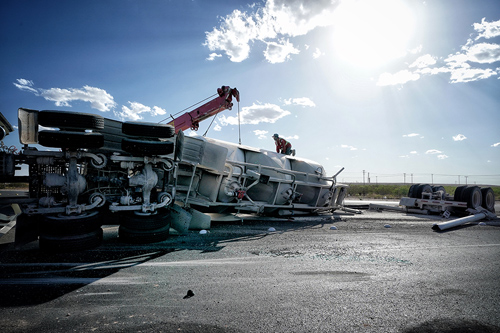
|
其他威脅來自土地本身。當地居民,尤其是佩斯科周邊的居民表示該地區經常發生地震。西爾斯說,3月的“每個星期四都地震了”,可以感覺到震動。佩斯科經濟開發公司(Pecos Economic Development Corporation)執行董事小肯尼斯·溫克斯和妻子住在離西爾斯家六個街區遠的地方。當溫克斯開著他的雪佛蘭Suburban帶我和西爾斯在鎮上兜圈時,他告訴我前一天晚上自己剛沖完淋浴,妻子就沖他喊道:“你感覺到了嗎?剛剛又晃了。”她的意思是地震。 二疊紀盆地的某些地區不光有地震,還有地陷。位于佩斯科東北的溫克鎮自稱為“石油和友誼構筑的城鎮”。幾十年來,它最出名的一點是鄉村搖滾歌手羅伊·歐比森曾經的家鄉。現在溫克鎮開始因為地陷而為人所知。早在1980年,鎮上就出現了一個特別深的塌陷坑。另一處則不是真的地陷,而是小鎮東北部201號縣公路路面上一系列不詳的彎折痕跡。 南衛理公會大學地球物理學教授盧仲(音譯,Lu Zhong)所在的科學團隊正在用衛星圖像來研究二疊紀盆地各處的地面沉降現象,該團隊認為這是一個危險信號。盧仲認為,油氣井破裂后逐步滲出的水溶解了地下鹽層,導致地面下沉,而某些地點最終會發生塌陷。他警告說,石油公司需要更好地維護老化油井,以免滲漏。盧仲對我說:“我們不打算指責誰。大家都在享受石油和天然氣帶來的繁榮。但我們可以利用一些技術來改善這些油井的健康狀況。” 當我告訴他我打算去看看201號縣公路出現“褶皺”的那段路時,他給了我一些建議:“我可不會把車停在那兒。”他還告誡我說,那條路隨時都可能“塌陷”。 2017年的最新統計數據顯示,在拉夫靈縣,也就是格里爾·布倫森的農場所在地,每5英里(8.5公里)才有一個人。該縣正式居民有134人,是美國人口第二少的縣,僅次于卡拉沃縣。后者位于夏威夷州,是一座銀色小島,19世紀曾作為麻風病人定居點。人口稀少往往會放大二疊紀盆地居民的巨大收益。 布倫森24歲的兒子埃文及其妻子泰勒住在米德蘭德郊區的一所房子里。一天晚上,我在這所房子的后院遇到了布倫森。布倫森把自家農場上新鉆出的三口油井命名為泰勒1號、泰勒2號和泰勒3號。泰勒則給我倒了一杯卡伯納沙維翁紅酒。這瓶酒來自南非一家釀酒廠,其所有者是布倫森家族某位成員的朋友。 |
Other dangers are coming from the ground itself. Residents, particularly around Pecos, report periodic earthquakes. In March, “it happened every Thursday,” says Mayor Seals, who says she felt the tremors. Kenneth Winkles Jr., executive director of the Pecos Economic Development Corporation, lives with his wife six blocks from Seals. As he, Seals, and I drive around Pecos in his Chevy Suburban, he tells me that the prior night, after he got out of the shower, his wife shouted to him: “Did you feel it? We just had another boom.” She meant the seismic sort. In some places in the Permian, the ground isn’t merely shaking, it’s caving in. Wink, a Permian town northeast of Pecos, calls itself “The City That Oil & Friendship Built.” For decades it was known mainly as the onetime home of Roy Orbison, the rockabilly crooner. Now Wink also is gaining fame for its sinkholes. One especially deep one developed as far back as 1980. Another isn’t yet a true sinkhole; it’s a series of ominous ripples in the asphalt on County Road 201, northeast of town. Zhong Lu, a geophysics professor at Southern Methodist University in Dallas, is part of a scientific team that has used satellite imagery to study what it regards as alarming land subsidence throughout the Permian. Over time, he believes, water from decaying oil-and-gas-related wells has leaked, dissolving subterranean salt layers and causing the ground to shift and ultimately, in places, to cave in. He warns that the industry needs to better shore up its aging wells against leaks. “We’re not trying to point fingers,” he tells me. “Everybody is enjoying the prosperity of oil and gas. But there’s technology we can use to modify the health of these wells.” When I mention to Lu that I’m planning to visit the cracking section of County Road 201, he offers some advice: “I wouldn’t park my car there.” At any time, he warns, the road might “collapse.” Loving County, where Grier Brunson’s ranch sits, has just one resident for every five miles, according to the latest count, in 2017. With 134 official residents, Loving is officially the second-least-populous county in the nation, behind Kalawao County, Hawaii, a tiny sliver of land that was set aside in the 1800s as a colony for people with leprosy. The emptiness of the landscape in the Permian tends to magnify the outsize benefits accruing to its beneficiaries. One night I meet Brunson in the backyard of the suburban Midland house where his 24-year-old son, Evan, and Evan’s wife, Taylor, live. Taylor, for whom the Brunsons have named three of the newest wells on the Loving County ranch—Taylor 1, Taylor 2, and Taylor 3—pours me a glass of Cabernet Sauvignon from a South African winery owned by friends of a member of the extended Brunson family. |
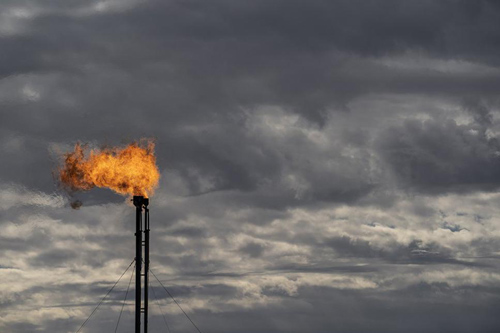
|
坐在躺椅上的布倫森開始給我講故事。有些跟他的祖父有關,“他在大蕭條、兩次世界大戰以及黑風暴事件中都一直苦苦經營著三個農場。那都是很艱難的日子”。另一個故事是1980年他們家農場上的一口油井發生了爆炸,油井燃起大火,因此得到了“布倫森焚燒者”的綽號。負責油井運營的是蓋蒂石油公司(Getty Oil),創始人是石油行業傳奇J. 保羅·格蒂。他有一句名言:“謙卑人必承受地土,而非其中的礦產權。”布倫森說:“這是我的準則。” 對于眼下規模空前的石油鉆井活動,布倫森很矛盾。出于這個原因,他整天都追著那些租下他們家采礦權的石油公司不放——他固執地強迫后者履行合同,盡量減少在地上留下的“瘡疤”。布倫森說:“我真的哭過,因為我親眼見到了人們對得克薩斯的傷害,而目的只是為了把地下的自然資源弄出來。” 就在他說話的同時,他們家農場上那片綠地周圍的鉆機依然在這個深夜,在西得州黑色的天空下運轉著。除非地理學家、投資者和來自世界各地的石油公司都大錯特錯了,否則二疊紀盆地這顆明星在今后幾年里依然會繼續升起。(財富中文網) 本文最初刊登在2018年6月1日出版的《財富》雜志上。 譯者:Charlie 審校:夏林 |
Brunson, sitting in a lawn chair, starts telling stories. Some are about his grandfather, “who husbanded these ranches through the Depression, two world wars, and the Dust Bowl. Those were hard times.” One is about a well on the family ranch that exploded in 1980, burning stupendously and earning the moniker the Brunson Burner. The operator of that well was Getty Oil, whose founder, the legendary oilman J. Paul Getty, had a famous line: “The meek shall inherit the earth, but not its mineral rights.” Says Brunson, “That’s my mantra.” But Brunson is conflicted about the unprecedented drilling going on today. That’s why he spends his days bird-dogging the oil companies to which his family has leased its mineral rights: He’s hell-bent on forcing them to honor their contracts and minimize the scars they leave on his land. “I have been literally crying because I have seen the damage done to Texas in my lifetime just to get natural resources out of this ground,” he says. As he speaks, late at night under a dark West Texas sky, the drilling rigs that ring the grassy draw on his ranch are still cranking. Unless geologists, investors, and oil companies from around the planet are dead wrong, the Permian’s star will be rising for years to come. This article originally appeared in the June 1, 2018 issue of Fortune. |













